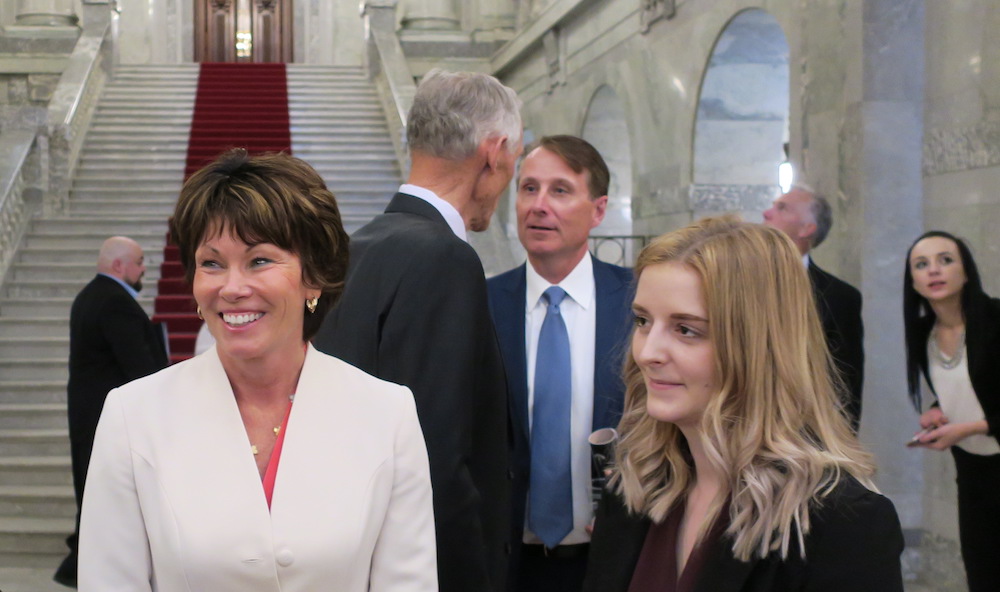It turns out the so-called Canadian Energy Centre, as the Kenney government’s $30-million subsidized lobbying campaign for the petroleum industry is now to be known, has been set up as a private corporation.
Previously commonly referred to by both friends and foes as the energy war room, the new corporation is supposedly intended to target “a deceitful campaign to landlock the oilsands,” as Energy Minister Sonya Savage described opposition to Alberta’s pipeline demands in her press release Wednesday announcing appointment of former journalist and payday loan lobbyist Tom Olsen as the entity’s managing director.
It’s interesting that the press release passed so lightly over the corporate structure of the government-owned private corporation, a legal formulation for a government front company that can fairly be described as both sketchy and bizarre.
“I think it would look rather unusual to have a corporation called War Room Inc.,” Savage told a CTV reporter on Wednesday. But that turned out to have been a bit of a diversion for those who assumed, as I did, that this must be a Crown corporation, given that the Crown owns it, or at least provided the dough to set it up.
Instead, as CBC investigative reporter Charles Rusnell revealed in a series of tweets yesterday, the war room will be a private corporation known as Canadian Energy Centre Ltd., legally headquartered in the 8th Avenue offices of Calgary law firm Burnet, Duckworth & Palmer LLP.
The directors of the corporation listed on its incorporation papers, a copy of which was attached to one of Rusnell’s tweets, are a trio of characters named Jason Nixon, Doug Schweitzer and Sonya Savage. Savage, of course, has already been introduced in this post. Nixon is the minister of environment and parks, and the government house leader in the legislature. Schweitzer is justice minister and attorney general of Alberta.
Rusnell noted that CECL’s curious corporate structure “means it’s not subject to Freedom of Info, so no way for opposition researchers, media or public to ferret out info.”
By yesterday afternoon, the United Conservative Party government had refined its talking point to explain this shady-sounding arrangement.
“The CEC’s internal operations are not subject to FOIP [Freedom of Information and Protection of Privacy], as this would provide a tactical and/or strategic advantage to the very foreign-funded special interests the CEC is looking to counter,” Premier Jason Kenney’s press secretary, Christine Myatt, told the CBC’s legislative reporter in an email.
“For example, we would not let those foreign-funded special interests seeking to attack our province see our detailed defence plans,” she continued, sticking to the government’s conspiracy theory — which was debunked by Vancouver Observer journalist Sandy Garossino on October 3 as “flatly and demonstrably false.”
While concern about what opponents might discover may indeed be part of the reasoning behind the CECL scheme, one suspects the motives may be considerably murkier. Keeping Albertans from knowing on whom their money is being spent, for example.
Of course, communications between the government and this new government department camouflaged by a bogus corporate structure could still be FOIPed, but I imagine efforts to avoid such scrutiny have also been considered.
Who can forget the 2011 case of the mysterious Frederick Lee, who turned out to be an alias used by former Conservative minster Ted Morton on an official government of Alberta email address to send and receive covert communications while he was minister of sustainable resource development? Frederick and Lee were Morton’s legal first and middle names.
I’m sure Rusnell — who as it happens also broke the Freddy Lee email story — will cast his FOIP net wide enough to capture any such emails from other Conservative Alberta politicians. If Google notices a flurry of new Gmail accounts being opened in Alberta, this may be the explanation.
Meanwhile, Olsen’s chances of success in his new role were not rated highly yesterday by political observers, some of whom took the matter less seriously than others.
“If a war room is to be judged by its general, this isn’t an encouraging sign,” tweeted Maclean’s magazine writer Jason Markusoff. “Olsen was a journalist held in high esteem (by the gov’t of the day), a press secretary (who often mangled the message) and a Kenney UCP candidate (who lost, in Calgary).”
Political blogger Dave Cournoyer suggested more kindly last night that even a PR genius might have problems flogging the message CECL has been set up to promote.
“While it may be easy for Kenney to dismiss NGOs and suggest that the 4,000 Albertans participating in the climate strike protest outside the legislature were communist sympathizers,” Cournoyer wrote on his Daveberta.ca blog, “Olsen’s war room will have a harder time dismissing its greatest opponent — the free market.”
After all, no matter how elaborate the conspiracy theories the Kenney government has set up CECL to promote, global markets have decided global warming is real.
“Alberta risks becoming increasingly isolated on energy and climate issues on the national and international stage,” Cournoyer concluded.
David Climenhaga, author of the Alberta Diary blog, is a journalist, author, journalism teacher, poet and trade union communicator who has worked in senior writing and editing positions with The Globe and Mail and the Calgary Herald. This post also appears on David Climenhaga’s blog, AlbertaPolitics.ca.
Image: David J. Climenhaga




